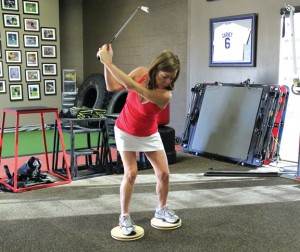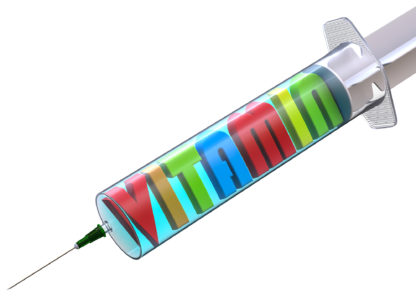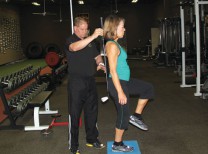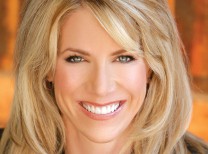
Sandi Young trains to improve her swing
Most people don’t look at golfers as athletes, but when you break down the swing, the forces generated in hitting a golf ball are quite impressive. An average golfer will swing a driver at around 80mph, while a professional can reach 120-130mph. If the body isn’t sequencing correctly, then those forces placed on the body have to be absorbed somewhere and it’s usually in the spine. All too often we see breakdowns in the swing because there is not range of motion to rotate hips, shoulders and trunk, so we end up overusing our arms by coming over the top, swaying and sliding. One of the biggest complaints from golfers over 50 is that all of a sudden they are losing distance, yet they feel that their swing hasn’t changed. Reduced power can be the result of a lot of swing faults, but can be helped with the right approach.
Other factors that reduce power are poor posture, bad alignment at address, and tight, restricted muscles.
Poor Posture
If you ever watch a small child play you will notice how their spine has so much movement, this is because they have not developed any bad habits yet. As we age and start to attend school and carry heavy backpacks, our posture becomes compromised. We slouch which puts stress on the spine and hips, which then carries into adulthood and our day-to-day jobs. Many Americans have desk jobs and are required to spend their days sitting and slouching. Most golfers are weekend warriors which means they spend their weekends trying to make up for lost time by playing as many holes as possible. By the end of the weekend, their backs, wrists and elbows are hurting.
Bad Alignment
Alignment issues are very common in golf and can predispose the golfer to physical problems down the road. Some obvious alignment issues include not bending forward from the hips but from the back, and rounded shoulders with tail tucked underneath the torso.
Tight, Restricted Muscles
Age, poor posture (as discussed), and not exercising or conditioning muscles correctly can all lead to restricted movement in the muscles and joints. Unfortunately, we as a country do not exercise enough and our everyday movement is limited.
Getting a thorough golf physical assessment and then starting a weekly exercise program is effective in addressing these issues and reducing the likelihood of injury. In my clinic I use the KVest 3d motion analysis system that gives valuable feedback to the golfer regarding numbers and angles during their swing. This data is collected, and with the physical assessment, they now can relate to what is actually happening with their body as it moves through their golf swing.
What happens with golfers who have had back surgery? These clients generally require special attention coupled with corrective exercises and stretching. Rehabilitation time may take longer, but the golfer will nearly always get back to golfing!
Golfers should train like athletes. He or she should use tailored work out plans throughout the year to maintain their overall fitness and strength. Golf really doesn’t have an off season so this makes it challenging for strength coaches to design the appropriate programs for certain times of the year. Not all golfers are equal, and in order to build strength a coach must carefully consider the individual. A general rule of thumb is to strengthen what is weak, and stretch those muscle groups that are tight, in order to achieve balance. Then we move on to balance – with an eye on mastering the many unbalanced surfaces that a golfer may face when playing.
Because many golfers don’t have time in their schedules to work out regularly, we prioritize the order, sequence and type of exercises that we give them to achieve optimal fitness. Below are a few foundational exercises that I recommend in a weekly regimen:
Deadlifts: An exercise that requires the ability to learn how to bend from the hips and sequence an order of movement from various muscle groups.
Pushing vs. pulling motions: I design pushing and pulling exercises into my program to achieve balance between muscle groups.
Front squats: This is a great exercise for a golfer to squat as deeply as they can safely demonstrate. The deeper the squat, the more one is using glutes, quads and hamstrings. This exercise also builds core strength and recruits scapular stabilizers and rotator cuff strength throughout the range of motion.
Rotational exercises: Like wood chops, medicine ball rotational lunges and high cable pulls, rotational exercise effectively activates many different muscles groups in 1 exercise.
Floor exercises: Exercises like kneeling opposite arm/leg, one-legged bridging, lower abdominal marching and prone cobra are great beginner exercises to develop core and glute muscles while sequencing movement patterns.
Mike Butler is co-owner of Kinetix Health and Performance in Palm Desert. He holds a state license as a physical therapist assistant, and national certifications of distinction through the NSCA as a strength and conditioning coach. He is a Poliquin International state coach and full body Active Release Techniques Practitioner. Mike can be reached at 760-200-1719; michael@kinetixcenter.com. www.kinetixcenter.com














































Comments (0)